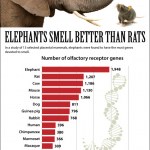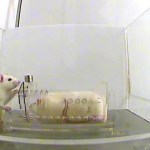Rat
Image of a rat in the New York City subway By m01229 from USA, from Wikimedia commons
News out of Flagstaff, Arizona reports that a biotechnology company in the area, SenesTech, has developed a birth control for rats that was recently cleared by the Environmental Protection Agency. The new drug comes in the form of a sweetened liquid bait that has been shown to reduce rodent populations by as much as 40%. It works in female rats by inducing loss of eggs whereas in male rats it disrupts development of sperm.
The drug is also being tested in other feral…
As I was perusing YouTube I came across a video from National Geographic that I must admit was fascinating while at the same time disturbing. The video describes how rats are able to travel from the sewer into your toilet.
Although this is reportedly an uncommon occurence, I will be sure to look before I sit from now on.
Image of Cricetomys gambianus from Wikipedia.
In a newly published study from Physiological Reports, researchers were interested in learning more about the basic physiology of African giant rats (Cricetomys gambianus). According to the study, heart rate is one of several "physiological constants" that offer a clue into how an animal might interact with its environment as heart rate may be influenced by season and patterns of food consumption among other variables. This particular species of rat is of interest as they are often kept as exotic pets while others …
Image from the American Physiological Society's website.http://www.the-aps.org/mm/Conferences/APS-Conferences/2014-Conferences/…
Tuesday was no less exciting than Monday!
Here are some highlights:
I thoroughly enjoyed a session called "Overcoming a Major Physiological Barrier: Adaptation from Saline to Freshwater Habitats" which highlighted the need for several species to shift how they regulate ion balance when they migrate between fresh water (ion absorption from the water) and salt water (ion secretion to the water).
Clements K, Bojarski L, Johnson K, McMillan S, White L, Angert E (Univ…
Like Aesop's fable, rats have another reason to be envious of elephants. Elephants also have significantly more genes that can detect different smells (i.e. olfactory receptor genes) than other super-sniffers like rats and dogs. In fact, compared to 13 other species, African elephants have 1,948 genes related to smell putting them ahead of the previous record holder, rats that only have about half as many genes. Primates have much fewer with only 296-396 of these olfactory receptor genes. Interestingly, the common ancestor of mammals had 781 olfactory genes, meaning that primates have lost…
Shivering is one mechanism by which heat is produced in the body. Heat production is called thermogenesis. Another mechanism is through nonshivering thermogenesis regulated by brown fat (i.e. adipose). This second type of heating mechanism kicks in when we need extra heat production such as a postnatal infant, someone developing a fever, an animal arousing from hibernation, eating, or in the case of the current study, stress.
A recent study published in the American Journal of Physiology provides evidence that during stressful events brown adipose tissue can elevate body temperature through…
...for rodents and men at least.
A team of researchers at UC Berkeley have discovered that mice infected with the parasite Toxoplasma gondii lose their innate fear of cats, even months after the infection is cleared. In fact, infected mice were mildly attracted to the odor of cats. This side effect likely evolved because the parasite can only sexually reproduce in a cat's gut necessitating ingestion of the parasite. Incidentally, other researchers have described the same side effects in rats and men (but not women). The findings suggest that the parasitic infection causes permanent…
Image of rat teeth from Scienceline (credit: The International Rice Research Institute, flickr.com)
What does tooth decay have to do with rats? For Neandertals, tooth decay was a rare occurance. Research suggests that tooth decay became more prominent with the development of agriculture. Dr. Ordaz, Stanford School of Medicine, and colleagues analyzed common strains of bacteria (Streptococcus mutans) responsible for causing cavities. They found that the bacteria began expanding exponentially around 10,000 years ago, similar to the dawn of agriculture. The…
Not joking. Researchers have managed to take cells from a rat and add them to a silicone layer to form a synthetic jellyfish that moves much like the real thing. The hope is to develop more complex organs that might be used for organ transplants in the future.
In this video, Dr. Jaak Panksepp describes how he discovered that rats apparently laugh, producing an ultrasonic sound which more resembles chirping than laughter as we typically think of it:
Further research by Dr. Panksepp has shown that young rats tend to be more ticklish that older rats and that "laughter" ceases when the animals smell the odor of a cat or when they are hungry. As you might expect, his findings have been debated by other scientists.
To read a recent interview with Dr. Pankseep about rat "laughter" and his theories, click here.
Sources:
Scientific American
http://falk.…
Photo: Science/AAAS
I find myself wondering why a rat would choose to liberate a cagemate when they have the opportunity to enjoy a goldmine of chocolates if they would just leave the other rat locked up. Dr. Peggy Mason, a neuroscientist, and psychologists Inbal Ben-Ami Bartal and Jean Decety conducted a study in which they placed pairs of rats in pens with one free to run about and the other placed in a restrainer in the middle. They found that 23 out of 30 rats freed their cagemate but did not bother to open empty restrainers or those containing stuffed rats. In another…
This post considering the evolutionary origins of numerical cognition, specifically in terms of the approximation of large numbers, is meant as a companion to this week's series on the developmental origins of numerical cognition and developmental dyscalculia, at Child's Play.
What are the origins of number representation in the mind? Are there any innate building blocks that contribute to our understanding of mathematics and number, or must everything be learned?
Number is an important domain of human knowledge. Many decisions in life are based on quantitative evidence, sometimes with life…
From the archives...
Figure 1: Does Mickey feel empathy?
It probably depends on how you define empathy. Empathy, by any definition, implies emotional sensitivity to the affective state of another. Sometimes the empathy response is automatic or reflexive, like when babies start to cry upon hearing another baby crying. Sometimes a strong cognitive component is required, such as for compassion. A more specific understanding of empathy requires similarity between the affective states of the observer and the observed, with an understanding that the observer feels a certain way because he has…
If you wanted to turn a rat into a fearless critter, unfazed by cats or bigger rats, the best way would be to neutralise a small pair of tiny structures in its brain called the dorsal premammillary nuclei, orPMD. According to new research by Simone Motta at the University of Sao Paolo, these small regions, nestled within a rat's hypothalamus, control its defensive instincts to both predators and other rats.
But not all neurons in the PMD are equal. It turns out that the structures are partitioned so that different bits respond to different threats. The front and side parts (the ventrolateral…







